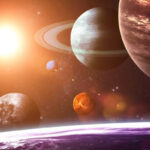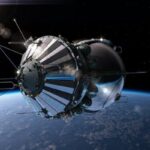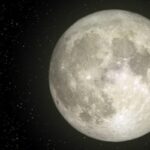We explain what natural satellites are and how they are classified. Also, what are its characteristics and the satellites of each planet.

What are natural satellites?
Natural satellites are celestial bodies that orbit around a planet or another celestial body that is not a star. The first natural satellite known to man was the Moon. The only planets in the solar system that do not have natural satellites are Mercury and Venus.
Satellites are solid bodies, usually without an atmosphere, of various sizes and densities. Some are small and rocky, while others are large and have more complex compositions.
A satellite enters orbit around a planet when it reaches a distance where two forces balance: the centrifugal force (which pushes the satellite outward) and the force of gravity (which attracts the satellite toward the planet). Therefore, satellites do not collide with the planets, but they do not move away from their orbit either.
In the same way as with the planets, the names of the satellites of the solar system were taken from Greek and Roman mythology. In the case of the satellites of Uranus, some of the names were adopted from characters in Shakespeare’s works.
Artificial satellites are created by humans and launched into space for specific purposes. They can be used for communication, Earth observation, scientific research or space exploration. Unlike natural satellites, artificial satellites are the product of human technology and do not form naturally in the solar system.
Characteristics of natural satellites
Natural satellites have the following characteristics:
- They orbit around a planet.
- They were formed naturally and by different processes.
- Except for Mercury and Venus, all the planets in the solar system have natural satellites.
- There are natural satellites of various sizes and composition.
- Ganymede is the largest satellite in the solar system.
- The Moon is the only natural satellite of the Earth.
Origins of natural satellites
The hypotheses of the formation of natural satellites are associated with different processes:
- Gravitational capture. Some natural satellites might have initially been celestial bodies in space that were captured by a planet’s gravity.
- Co-formation. In some cases, natural satellites may have formed at the same time as the planet they are associated with. This process implies that both the planet and its satellite were formed from the same original material.
- Impacts. A giant impact between a celestial object and a planet could have resulted in the ejection of material that eventually condensed to form a satellite. This process has been proposed as a possible explanation for the formation of the Moon.
Types of natural satellites
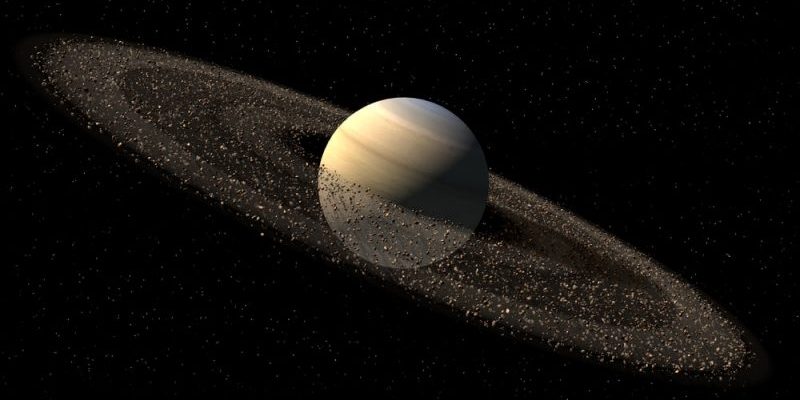
There are several types of natural satellites in the solar system, and each one has unique characteristics depending on its origin and orbital behavior:
- Shepherd satellites. They are satellites found in the planetary rings of Jupiter, Saturn, Uranus and Neptune. These satellites help maintain the shape of the ring by exerting gravitational influence and prevent particles from scattering due to gravitational perturbations from other planets. An example of a shepherd satellite is Pan, which is located in Saturn’s ring system.
- Coorbital satellites. They are satellites that rotate in the same orbit. The satellites Janus and Epistemus of Saturn are examples of co-orbital satellites.
- Asteroid satellites. They are satellites that orbit an asteroid. They are also known as Trojan asteroids. Dactyl is an example of an asteroidal satellite, and it orbits the asteroid Ida.
Types of orbits of natural satellites
According to their movement and orbit, natural satellites are classified into two types:
- Regular. These satellites rotate in the same direction as the planet, that is, they maintain a constant orbit around the largest celestial body. Examples of these satellites are the Moon, Ganymede, Europa, Titan, Miranda and Oberon.
- Irregular. These satellites have orbits very far from the planet and their orbits are generally elliptical (elongated) and very inclined. It is believed that these satellites were asteroids that were captured by the planet’s gravitational force and that is why they have distant orbits.
How many natural satellites does each planet have?
Except for Mercury and Venus, all the other planets in the solar system have natural satellites:
- Land. It has only one natural satellite, the Moon.
- Mars. It has two natural satellites, called Phobos and Deimos.
- Jupiter. It has more than 80 known natural satellites. The most important are Io, Europa, Ganymede and Callisto. Ganymede is the largest natural satellite in the solar system and the only one that has its own magnetic field.
- Saturn. It has 82 known natural satellites. The most important are Titan, Enceladus, Rhea, Dione and Mimas.
- Uranus. It has 27 known natural satellites. Some of the most notable are Ariel, Miranda, Umbriel, Titania and Oberon.
- Neptune. It has 14 known natural satellites. Some of the most important are Triton, Proteus, Nereid and Larisa.
The Moon
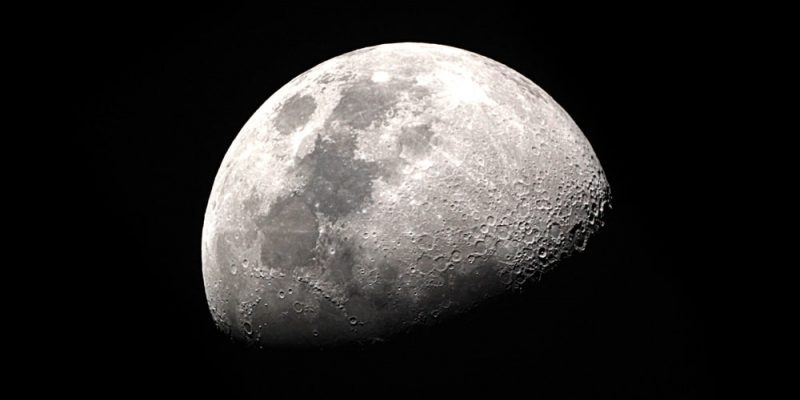
The Moon is the only natural satellite of the Earth. Its diameter is 3,474 kilometers (a quarter of the diameter of the Earth), making it the fifth largest satellite in the solar system. Its orbit around the planet takes approximately 27.3 days to complete one revolution.
A characteristic of the Moon is that it always shows the same face to the Earth, a phenomenon known as synchronous rotation. This is because the Moon’s rotation around its own axis takes the same time as its orbit around the Earth.
The Moon is believed to have formed about 4.5 billion years ago, from the remains of a collision between the early Earth and a Mars-sized object known as Theia. The debris from this collision would have consolidated to form the Moon.
The Moon plays a critical role in stabilizing the tilt of the Earth’s axis of rotation. Furthermore, the disparity between the gravitational forces of the Earth and the Moon is what gives rise to the tides.
Enceladus
Enceladus is one of Saturn’s satellitesand with only 500 kilometers in diameter it is one of the most active celestial bodies in the solar system. This is due to the more than one hundred geysers that are found on its surface. These jets of material expelled from its interior can reach significant altitudes before falling back to the surface. Due to the low temperatures, the expelled water falls back to the surface in the form of snow and the rest is dispersed throughout the planetary ring to which Enceladus belongs.
Scientists have used these measurements to infer the presence of a subsurface ocean at Enceladus’ south pole. The activity of the geysers suggests that beneath the ice sheet there is a source of heat that keeps the water in a liquid state.
The existence of a subsurface ocean has important implications, as it could provide a potentially habitable environment for microscopic life forms similar to those found in Earth’s ocean depths.
Ganymede
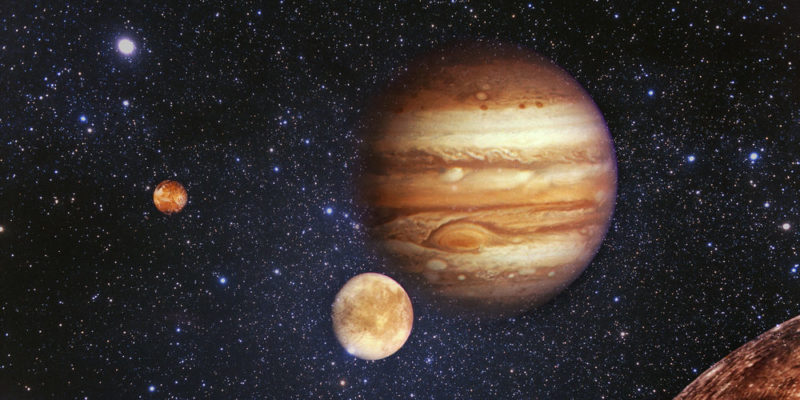
Ganymede is the largest natural satellite in the solar system. It was discovered by Galileo Galilei in 1610, along with other satellites such as Io, Europa and Callisto. It has a diameter of approximately 5,268 kilometers, making it larger than Pluto.
Its composition is characterized by the predominant presence of solid water and silicates, which allows scientists to assume that it has an internal structure with a rocky core and an icy surface.
Ganymede is the only satellite in the solar system that has its own magnetic field. This occurs due to its interaction with Jupiter’s powerful magnetic field.
References
- Exploratorium. (2023). Information about the Moon. https://www.exploratorium.edu/es/
- Milo, A. (2023). What is a natural satellite and how many are there in the Solar System?. National Geographic in Spanish. https://www.ngenespanol.com/
- Núñez, S. (2022). What are tides and why they occur. EcologyGreen. https://www.ecologiaverde.com/

